Here is a Map of the Whitechapel District circa 1888 as they pertain to the Ripper Case.
One of the most famous works on the "Ripper Case" is actually a novel written by Marie Adelaide Belloc Lowndes “The Lodger: A Story of the London Fog” published in 1913. The book is in public domain and a very good read, but what we might today call somewhat of a Women’s Romance novel of the period.
Basically the story tells of a typical middle class 19th Century British husband and wife who used to be domestic servants and are now in need of extra money. They rent a room to a mysterious young man: "Mr. Slade". Their “Lodger” has some very strange quirks in the eyes of the wife. He only goes out at night, wants his meals left in front of the door rather than joining the family at the dinning table, reads a large bible which he has totally memorized, removes every picture with women because they are "entertainers" from the walls of his room, carries what appears to be a Doctor’s black bag and does small experiments which utilizes the houses basement furnace at times.
The wife, who is the main character of the story, begins to have suspicions that her Lodger is in reality “The Avenger”. "The Avenger" is the name author Marie Belloc Lowdes gives her Jack the Ripper character in the novel. The wife and her husband have a daughter, Daisy, who is also an entertainer. Daisy's boyfriend just happens to be a Scotland Yard Inspector.
The wife, who is the main character of the story, begins to have suspicions that her Lodger is in reality “The Avenger”. "The Avenger" is the name author Marie Belloc Lowdes gives her Jack the Ripper character in the novel. The wife and her husband have a daughter, Daisy, who is also an entertainer. Daisy's boyfriend just happens to be a Scotland Yard Inspector.
Marie Lowndes fiction would be made into five movies starting in 1927 by Alfred Hitchcock. Motion Pictures had mentioned the Ripper even earlier than the Hitchcock film, have had both Sherlock Holmes and H.G. Wells solve the case, and played upon our love of mystery and our fascination with these grisly murders. Along with attempting to answer the still unsolved question:
"Who was Jack the Ripper and what happened to him?"
"Who was Jack the Ripper and what happened to him?"
As I have said this article is a look at the character of “Jack the Ripper” in motion pictures and television. As I have already mentioned the novel by Marie Adelaide Belloc Lowndes, which is still considered a classic mystery, is truly the start of the guesses. So the different motion picture versions are the logical place to begin.
The first film was released February 14, 1927 with a running time of 80 minutes.
Using the books title “The Lodger: A Story of the London Fog” it was directed by Alfred Hitchcock and has several interesting aspects to it that show the young Hitchcock’s take on film.


Although he had filmed other pictures the “Lodger” is the first film “Hitch” makes his trademark cameo appearance in. You will find him sitting with his back to the audience about three minutes into the motion picture speaking on a telephone in the newsroom.
Although he had filmed other pictures the “Lodger” is the first film “Hitch” makes his trademark cameo appearance in. You will find him sitting with his back to the audience about three minutes into the motion picture speaking on a telephone in the newsroom.
One innovation Hitchcock made is in a scene looking down upon actor Ivor Novello as Jonathan Drew “The Lodger” as he walks back and forth in his upstairs room. What made this scene truly Hitchcockian is that the floor was made of heavy plate glass and as Novello walks back and forth you also see the interaction between the other characters on the other floor below as they discuss who “The Avenger” might be.
Being a silent film Hitchcock also used newspaper headlines, teletype strips, newspaper sellers wearing clapboards and posted handbills as often as possible to tell the dialogue of his story. This technique involved the audience with more of the filmed action rather than breaking away to read the normally used title cards.
The film catches the audience at the beginning as we see a young blonde women, framed against a sheet of glass, with her hair illuminated. She is the latest victim of a killer “The Avenger” who kills only Blonde Prostitutes. Another change Hitchcock made to the novel as he felt blonde hair stood out on the black and white film of the period. He also felt it got the audience to start looking at any blonde actress he used even in a crowd scene as a potential victim.
The film catches the audience at the beginning as we see a young blonde women, framed against a sheet of glass, with her hair illuminated. She is the latest victim of a killer “The Avenger” who kills only Blonde Prostitutes. Another change Hitchcock made to the novel as he felt blonde hair stood out on the black and white film of the period. He also felt it got the audience to start looking at any blonde actress he used even in a crowd scene as a potential victim.
Jonathan Drew rents a room from the Bunting’s whose daughter Daisy is a dancer and of course blonde. Her boyfriend Joe Chandler is a policeman assigned to “The Avenger” case. The relationships between Joe, Daisy and Jonathan form the bulk of the story as Mrs. Bunting begins to suspect Drew of being the killer.
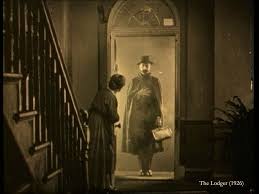
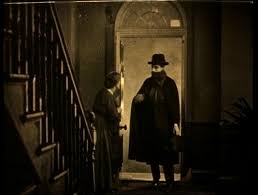


Another Hitchcock twist on the novel and the known facts in the Ripper case is that “The Lodger” and Daisy are falling in love with each other. Joe arrests Drew accusing him of being “The Avenger”, but Drew escapes with his handcuffs still on. Daisy follows him and at the climax of the film a mob from a local pub attacks Jonathan after seeing the cuffs. They are convinced he is the killer. Joe arrives and with Daisy attempts to stop the fierce beating which brings us to a typical Alfred Hitchcock ending. A young boy brings in a newspaper report that the real killer has been caught. Unlike the novel “The Lodger” is not the Ripper.
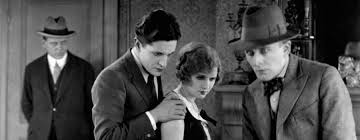
Above with hands on Daisy, played by June Tripp, is Ivor Novello as "The Lodger" and to the right is Malcolm Keen as Joe Chandler.
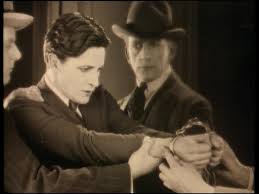
Here is a link to an excellent print of Hitchcock;s motion picture, as of this writing:
https://www.youtube.com/watch?v=PzlVNRzU1FE
Above with hands on Daisy, played by June Tripp, is Ivor Novello as "The Lodger" and to the right is Malcolm Keen as Joe Chandler.
Here is a link to an excellent print of Hitchcock;s motion picture, as of this writing:
https://www.youtube.com/watch?v=PzlVNRzU1FE
The second version was released in the U.K. in 1933 as “The Lodger.” In the United States the film was released in 1935 as “The Phantom Fiend” both titles with a running time of 67 minutes.

What makes this film interesting is not only is this the first sound version of the novel, but it also starred Ivor Novello as the Lodger. This time his character was not named Jonathan Drew, but Michael Angeloff. An Hungarian musician, who takes lodging at the home of the parents of Daisy Bunting.
Playing Daisy was Elizabeth Allan who would appear opposite Ronald Coleman in “A Tale of Two Cities” and star in Todd Browning’s film “Mark of the Vampire” both released in 1935 among other 1930 and 40’s performances. Playing the police inspector now called Joe Martin was a young Jack Hawkins.



This film is very much a remake of the Hitchcock script with only major change being Novello’s character as a foreign musician and idea that “The Avenger” is a foreign musician also.
Here is the link to the first talkie "Jack the Ripper":
https://www.youtube.com/watch?v=0x7HARqwFvA
Here is the link to the first talkie "Jack the Ripper":
https://www.youtube.com/watch?v=0x7HARqwFvA
The third version of the novel was simply called “The Lodger” and it was released January 19, 1944 with a running time of 84 minutes. It is considered, to date, the definitive version of the novel. Although it also takes liberties with it.
The 20th Century Fox motion picture was a major production for the year. It stared Merle Oberon as Daisy, Laird Cregar as an eerie and moody Mr. Slade “The Lodger”, George Sanders as Inspector John Warwick, Sir Cedric Hardwick as Robert Bonting and Sara Allgood as his wife Ellen Bonting. As with the previous versions the names of the characters from the original novel keep changing.


While the first two films took place in their respective years of 1927 and 1933, 20th Century Fox set their picture in the correct year of the Ripper murders 1888. Making it the first "period" version. The movie still has the romantic involvement between Daisy and the Police Inspector as in the previous two films and the original novel, but Mr. Slade is not part of a love triangle as created by Alfred Hitchcock. In this motion picture there is no doubt to the audience that he is "Jack the Ripper". At the the climax "Mr. Slade" kills himself be jumping into the Thames to avoid being taken alive. It is Laird Cregar’s sensitive and haunting performance which truly captures you.


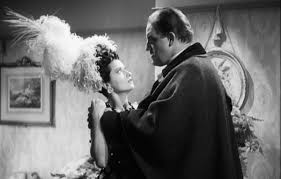



As previously here is the link to the 1944 version of Marie Adelaide Belloc Lowndes' novel:
https://www.youtube.com/watch?v=-Vk0LtNJ7o8
As previously here is the link to the 1944 version of Marie Adelaide Belloc Lowndes' novel:
https://www.youtube.com/watch?v=-Vk0LtNJ7o8
The fourth version of the novel was entitled “Man in the Attic” released on December 23, 1953 with a running time of 82 minutes.
The film stars Jack Palance as Slade, Actress Constance Smith is no longer called Daisy but Lily Bonner. Unlike the previous films and novel she has no relationship to her landlords Mr. and Mrs. Harley. The Police Inspector is now called Paul Warwick. Like the 1944 film this motion picture was made by 20th Century Fox. It uses almost the exact script for the previous film except for the name changes noted. This is another of those under rated performance by Palance and is equal in many ways to Cregar’s. Both making excellent psychopaths who may, or may not be the killer known in the novel as "The Avenger".




As with the previous four films here is a link should my reader be interested in comparing the two 20th Century Fox motion pictures:
https://www.youtube.com/watch?v=xBmmG0tUWyQ
As with the previous four films here is a link should my reader be interested in comparing the two 20th Century Fox motion pictures:
https://www.youtube.com/watch?v=xBmmG0tUWyQ
The fifth and last version so far of Marie Belloc Lowndes’ novel was released January 23, 2009 and is the longest version of the novel at a running time of 95 minutes.
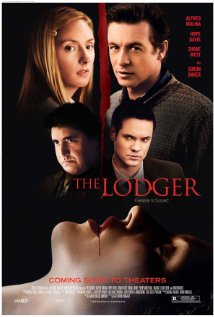

As with the first two films the movie takes place in the year of the production and unlike the four previous films and the novel has a double story line that will intersect. The first tells the audience about the troubled detective Chandler Manning, Alfred Molina, and his daughter Amanda played by Rachel Lee Cook. Manning seems to be playing a cat and mouse game with a serial killer seemingly copying "Jack the Ripper".
The second story line is more to the novel as Ellen Bunting, Hope Davis, and her husband Joe Bunting, Donal Logue, deal with a mysterious stranger Malcolm Slaight, Simon Baker, their lodger. Who of course Mrs. Bunting is starting to believe is the serial killer terrorizing their neighborhood. The film has a twist at the end as to who the real serial killer is.
The movie uses Marie Adelaide Belloc Lowndes' novel's title as a lure for audiences familiar with it, or the original motion pictures. However, other than the idea of the killings to detective Manning being related to the 1888 event. The film really has nothing to do with the novel.
As New York Times movie critic Jeannette Catsoulis wrote on January 22, 2009 about the screenplay:

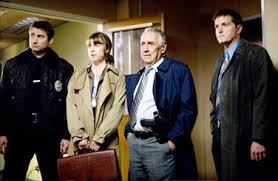


I expect "The Lodger" will come back sometime in the future in another production, but now I turn away from it and look at all the other movie versions of the Ripper's story as imaginative film makers have told it.
Here is the motion pictures trailer:
https://www.youtube.com/watch?v=U1mbLfwSriM
The second story line is more to the novel as Ellen Bunting, Hope Davis, and her husband Joe Bunting, Donal Logue, deal with a mysterious stranger Malcolm Slaight, Simon Baker, their lodger. Who of course Mrs. Bunting is starting to believe is the serial killer terrorizing their neighborhood. The film has a twist at the end as to who the real serial killer is.
The movie uses Marie Adelaide Belloc Lowndes' novel's title as a lure for audiences familiar with it, or the original motion pictures. However, other than the idea of the killings to detective Manning being related to the 1888 event. The film really has nothing to do with the novel.
As New York Times movie critic Jeannette Catsoulis wrote on January 22, 2009 about the screenplay:
Perhaps he should have tackled the screenplay. Mr. Ondaatje’s witless adaptation of the 1913 novel by Marie Belloc Lowndes (also the basis of the 1927 Hitchcock silent of the same name) leaves his talented cast floundering. Less interested in flushing out the killer than in manipulating the image, Mr. Ondaatje stuffs the screen with scudding clouds, speeded-up traffic and inexplicable lapses into black and white. And though the story jolts to life two-thirds of the way in, its director barely notices: he’s much too busy clinging to an imperiled hooker’s swaying behind.
I expect "The Lodger" will come back sometime in the future in another production, but now I turn away from it and look at all the other movie versions of the Ripper's story as imaginative film makers have told it.
Here is the motion pictures trailer:
https://www.youtube.com/watch?v=U1mbLfwSriM
The original mentioning of “Jack the Ripper” in motion pictures was in a German film released there on November 13, 1924 “Das Wachsfigurenkabinett (Waxworks), but the picture is not really a story of his crimes. This movie like a second German film made five years later and also from the end of the silent era uses the character in a cameo role.
“Waxworks” tells of a young poet hired to write biographies of the exhibits at a local “House of Wax”. They include Ivan the Terrible, the Caliph of Bagdad and Jack the Ripper. The film was made as an anthology within the story of the writer. So depending upon which character’s story we watch. It is either historical, fantasy, or mystery with a touch of horror.

The great German silent screen actor Emil Jennings plays the Caliph, Conrad Veidt is Ivan the Terrible and Werner Krauss is Jack the Ripper. Veidt played Caesar the somnambulist and Krauss the title doctor in “The Cabinet of Dr. Caligari” from 1921.

The Caliph

Ivan the Terrible

Jack the Ripper
The Caliph
Ivan the Terrible
Jack the Ripper
The poet falls in love with the daughter of the owner of the “Waxworks” during the film. After working on the first two stories he falls asleep, but something wakes him up. Looking around he notices that the wax figure of the Ripper is missing. He hears screams and moving through the twisted halls finds the Ripper about to kill the women he loves. The two start to flee from the Ripper, but can’t. As Jack moves closer to them preparing to kill the two. The poet awakes from a dream within a dream.
Here is the link to this German silent horror classic:
https://www.youtube.com/watch?v=3nksb9EBZKI
Here is the link to this German silent horror classic:
https://www.youtube.com/watch?v=3nksb9EBZKI
1929's “Die Buches der Pandora (Pandora’s Box)” was that other German film, but it starred popular American actress Louise Brooks and German actor Francis Lederer. Lederer would go to Hollywood and play many a Nazi during the 1940’s and in 1958 the title character in a favorite film of mine “The Return of Dracula”. Depending on which American edit of the film you see. The movie will run between 100 and 152 minutes, but the German director’s cut is only 133 minutes in length.


As with “Waxworks” the Ripper is nothing but a character used at the end of the film for retribution. At least in the original German version and the longer United States restored cut. The story follows Brooks as Lulu the mistress of a respected newspaper publisher. Her best friend, Lederer, happens to be the son of the publisher. The film has a convoluted plot revolving around Lulu and the publisher whom she marries.

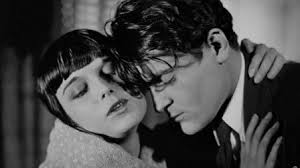
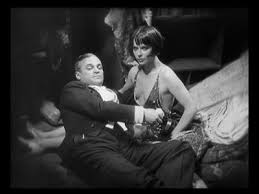
At the wedding reception for Lulu and the publisher it is discovered that Lulu is really the daughter of a shady character named Schigolch. After the guests have left the publisher finds his wife in the bedchamber with both her father and another man Rodrigo Quast. The publisher once alone with his new bride hands her a gun and tells Lulu to kill herself, because of the scandal she has brought upon him. In a struggle over the gun the publisher is killed and Lulu is tried, convicted of manslaughter and sentenced to five years in prison. Her father and Quast set off a fire alarm at the courthouse and flee with Lulu. Eventually she becomes a prostitute in Egypt and turns to her father for help. In a confrontation with Quast she kills him and flees with to London where she works the streets as a prostitute to survive.
Enter Jack the Ripper whom she unknowingly picks up as a client. They have a conversation where the Ripper confesses he has no money. Lulu invites him to her lodgings anyway. Touched by her sincerity the Ripper throws away his knife before entering her drafty London Garrett. However, he spots another knife and his urge to kill takes over. Both her father and the publisher’s son have been looking for Lulu and the film ends without them ever finding out what happened. In 1980 there was a German/French/Italian remake of the film called “Lulu”.
So who was the real Jack the Ripper?
What are known to history as either the “Ripper”, or “Leather Apron” murders took place between August 31st and November 9th 1888 and were only five in number, His victims are Mary Ann Nichols, Annie Chapman, Elizabeth Stride, Catherine Eddowes and Mary Jane Kelly all prostitutes of varying ages. These ladies of the night are referred to as “The Canonical Five”.
What the movies based upon this crime spree, several written investigative books and many of the television specials never mention is that following the death of Kelly there were eleven more brutal murders lasting into 1891. Scotland Yard always claimed they could not connect these with “Jack” or was the Yard deliberately avoiding telling the public at the time they were to avoid further panic? At the least Scotland Yard was faced with one copy cat murderer of prostitutes in the Whitechapel area for another three years after the death of Mary Jane Kelly.
What the movies based upon this crime spree, several written investigative books and many of the television specials never mention is that following the death of Kelly there were eleven more brutal murders lasting into 1891. Scotland Yard always claimed they could not connect these with “Jack” or was the Yard deliberately avoiding telling the public at the time they were to avoid further panic? At the least Scotland Yard was faced with one copy cat murderer of prostitutes in the Whitechapel area for another three years after the death of Mary Jane Kelly.
Police Records of the Victorian period that are still available indicate that over 2,000 people were interviewed, close to 300 investigated and 80 detained in the Ripper case. Additionally Scotland Yard collected forensic material from the crimes to compare. Although the investigation was initially conducted by the “Metropolitan Police Whitechapel (H) Division Criminal Investigation Department (CID) headed by Detective Inspector Edmund Reid, because of the political situation it was causing Scotland Yard entered the investigation. The case was assigned to three Detective Inspectors Frederick Abberline, Henry Moore and Walter Andrews. Abberline is centered out in some movies, documentary films and the Graphic Novel “From Hell” as the main investigator of the murders.
So who was he as compared to the cinematic versions which would include actors Michael Caine and Johnny Depp?
At the time of his assignment to the Ripper Case Frederick George Abberline had been previously married twice. According to future Chief Inspector Walter Drew, Abberline was the best choice to lead the Scotland Yard investigation as he was originally part of “A Division” located in the Whitechapel District. He knew the area, he knew the people and he knew the prostitutes. His promotion to Lead Inspector on the case came immediately after the first murder of Mary Ann Nichols.

Chief Inspector Frederick George Abberline

Chief Inspector Frederick George Abberline
Although there were those then and still who want to tie the killer to the Royal Family. Abberline considered Severin Antoniovich Klosowski aka George Chapman his primary suspect. Klosowski was from Poland and at the age of 14 was an apprentice to a surgeon where he assisted in applying leeches for blood-letting. Later he enrolled in a course of practical surgery at the Warsaw Praga hospital. Klosowski served as both a male nurse and doctor’s assistant in Warsaw until he left in December 1886. The date Klosowski arrived in London cannot be positively confirmed, but according to witnesses who knew him. He was unknown prior to 1888, but other sources indicate he was in England sometime prior to that year. Severin would change his name originally to Ludwig Schloski, marry a young Polish girl and has a child by her. However, the now Ludwig Schloski's first wife from his home country of Poland shows up in London and confronts the second. What followed is undocumented, but Klosowski/Schloski seems to have gone back to his first wife and deserted his second and child.
At some point Klosowski changes his name a second time to George Chapman. Klosowski as Chapman had several mistresses and three of them he poisoned. Mary Spink died December 25, 1897, Bessie Taylor died on February 14, 1901 and Maud Marsh died on October 22, 1902. Suspicions over the death of Marsh led to the other two women and Severin Antoniovich Klosowski aka: Ludwig Schloski aka: George Chapman was tried and hung on March 19, 1903.

George Chapman
George Chapman
According to Peter De Loriol in his 2010 book “Murder and Crime in London” pages 61 and 62:
Abberline thought Chapman was Jack the Ripper because during the "Jack the Ripper" frenzy he had closely interviewed his first "wife" since arriving in England, Lucie Badewski, and she had told him that her husband often used to go out during the night for hours on end.
Philip Sugden in “The Complete History of Jack the Ripper” page 465 stated:
Chapman is the most likely candidate among known Ripper suspects, but that the case against him is far from proven.This is because of the lack of supportive facts from Abberline leaving his charges against George Chapman open to speculation.
Some investigators and writers think otherwise though and have their own ideas as to who the “Ripper” was including tying him to a similar string of murders that happened shortly afterwards in the United States. Believing that Jack migrated from England.
It should be noted that Abberline would become Chief Inspector of Scotland Yard right after the Ripper case. He would be involved in several major crime cases such as “The Cleveland Street scandal”concerning a male brothel. It has an indirect relationship to the possible identity of "Jack the Ripper" and I will go into the details later in this article.
The real Chief Inspector Frederick Abberline would die at his home in 1929 at the age of 86. However, when the motion pictures actually mention anyone on the case by name they go to Frederick Abberline and change his life even to either that of an alcoholic, a drug addict, or both. Abberline also has appeared in the anime series “Black Butler”, the 2010 movie remake of “The Wolfman” and the "Dr. Who" comic “Ripper’s Curse”.
The real Chief Inspector Frederick Abberline would die at his home in 1929 at the age of 86. However, when the motion pictures actually mention anyone on the case by name they go to Frederick Abberline and change his life even to either that of an alcoholic, a drug addict, or both. Abberline also has appeared in the anime series “Black Butler”, the 2010 movie remake of “The Wolfman” and the "Dr. Who" comic “Ripper’s Curse”.
The first dramatic television program about the Ripper is available for download as the series was never sold. The series was called “The Veil” created by motion picture producer Hal Roach and starred Boris Karloff as both host and participant in nine of the 10 episodes. The tenth episode was about Jack the Ripper. I will not reveal the ending should you like to view this excellent entry, but give you just one review by an on-line viewer for your consideration of this 1958 episode:
“Author: capkronos (capkronos00@hotmail.com) from Ohio, USA
21 January 2009
21 January 2009
Professional clairvoyant Walter Durst (Niall MacGinnis, remembered by horror fans for his great role in the classic British chiller NIGHT OF THE DEMON, filmed a year earlier) dreams of Jack the Ripper's Whitechapel prostitute murders a few hours before they occur. His wife Judith (Dorothy Alison) encourages him to go to the police because they could use the publicity for their business. Because of a bunch of phony psychics that show up at around the same time, Scotland Yard detectives (led by Clifford Evans as Inspector McWilliams) don't initially believe him until he's able to give non-published details about one of the crimes. Feeling he could only know what he does because he's actually responsible, they promptly lock him up, but another murder occurs while he's behind bars. He's then freed and the detectives enlist his aid in trying to capture the killer. Though the whole Jack the Ripper story has been filmed dozens of times for both TV and the big screen, the addition of the clairvoyant aspect, as well as the performance from MacGinnis, provide some additional interest for this particular adaptation.
Unlike the other nine episodes, this was NOT filmed especially for "The Veil," though it does fit in well with the others since the series is made up of tales supposedly based on actual occurrences and containing some element of the supernatural. It was made in England by director David MacDonald (DEVIL GIRL FROM MARS) and was picked up for distribution in the U.S. by Hal Roach Studios, That included it as the tenth and final episode of this unsold series. I'm not really sure of this short film's origins, which runs less than 20 minutes minus the book-ending Karloff footage. Perhaps it was made for British TV, or could have easily been an unfinished feature-length project at one point. Unlike the others, where Karloff played both host and an additional role in each episode, Boris only appears as host here, providing his usual intro ("Good evening. Tonight I'm going to tell you another strange and unusual story on the unexplainable, from behind The Veil."), as well as an intermission and a closing. However, the presence of MacGinnis compensates for Karloff's absence.Here is the "Jack the Ripper" episode:
https://www.youtube.com/watch?v=Lyk447aN52w
Staying with television are three interesting programs from the 1960’s. The first again was hosted by Boris Karloff in another anthology series that did sell “Thriller”. The episode from April 11, 1961 was entitled: “Yours Truly Jack the Ripper” written originally as a short story by Robert Boch the author of “Psycho” and directed by actor Ray Milland described on IMDb:
70 years after the Jack the Ripper killings in London, Sir Guy (John Williams) convinces the police that Jack may still be alive, eternally young, and still killing, currently in New York.
Of course Sir Guy is correct and discovers the truth at the end before he is killed by the Ripper who he has been telling his story too.

Original Book Cover
Here is a link to the website "Divisions of the Groovy Kind" about a comic book adaptation of Robert Bloch's story:
http://diversionsofthegroovykind.blogspot.com/2012/04/scarier-than-doing-your-taxes-week.html
Original Book Cover
Here is a link to the website "Divisions of the Groovy Kind" about a comic book adaptation of Robert Bloch's story:
http://diversionsofthegroovykind.blogspot.com/2012/04/scarier-than-doing-your-taxes-week.html
December 22, 1967 saw Chief Engineer Montgomery Scott accused of murdering a women from a pleasure planet during the “Star Trek" episode "Wolf in the Fold". Scotty was possessed by an entity that feeds on fear and terror and is traced back to Jack the Ripper in 1888. The story had its origin with a short story “Le Horla (The Horla)” written one year prior to the Ripper murders by French author Guy de Maupassant. The original story was made into the 1963 Vincent Price film “Diary of a Madman”.


In an interesting twist on the Ripper case and owing to the idea that he came to America. On January 25, 1968 the Western series “Cimarron Strip” found Stuart Whitman’s main character of Marshall Crown facing off against Jack the Ripper in the American West. The story “Knife in the Darkness” was written by Science Fiction/Horror author Harlan Ellison.
During the 11th Doctor Who played by Matt Smith as a "Good Man Goes to War" June 4, 2011. We learn that Silurian Madame Vastra turned Victorian England Detective. While on a special assignment from Scotland Yard has tracked down Jack the Ripper and eaten him. Thereby ending his 1888 reign of terror in Whitechapel.


During the 11th Doctor Who played by Matt Smith as a "Good Man Goes to War" June 4, 2011. We learn that Silurian Madame Vastra turned Victorian England Detective. While on a special assignment from Scotland Yard has tracked down Jack the Ripper and eaten him. Thereby ending his 1888 reign of terror in Whitechapel.
The first motion picture or television show to actually claim to tell the "TRUE EVENTS" was a 1959 British film entitled appropriately enough: “Jack the Ripper”. It was released May 28, 1959 in the U,K. and on February 17, 1960 in the United States. The picture was very loosely based upon the theory that Jack was actually a surgeon. Other than that the story is a complete fiction playing off the title character’s name to draw in an audience. So how could this movie be the "TRUE" anything?




Scotland Yard Inspector O’Neil greets his friend New York City Detective Sam Lowry and the two solve the Ripper murders revealing the killer at the films climax. However, if you haven’t figured out the ending by a quarter of the way into this turkey you are slow.




According to promoter Joseph E. Levine he purchased the United States rights to the motion picture for 50,000 pounds, invested a million dollars and made a profit of a million. The following link is the ending of the movie where Jack gets his comeuppance with a trick of adding color for a split second that Levine used as part of his PR campagin.
https://www.youtube.com/watch?v=KmOX9C-nO_4
According to promoter Joseph E. Levine he purchased the United States rights to the motion picture for 50,000 pounds, invested a million dollars and made a profit of a million. The following link is the ending of the movie where Jack gets his comeuppance with a trick of adding color for a split second that Levine used as part of his PR campagin.
https://www.youtube.com/watch?v=KmOX9C-nO_4
The films that followed where pure entertainment and never claimed to be otherwise.
The next feature film to tackle the story of the Ripper was in 1965 and its title was a play on a Sherlock Holmes novel by Sir Arthur Conan Doyle “A Study in Scarlet”. The film was “A Study in Terror” and was the first to pit Sherlock Homes against the Whitechapel murderer.
Note the poster for the film that illustrates how popular the Adam West/Bruce Ward "Batman" television show was at the time and the thought by the distributor Columbia Pictures that Sherlock Holmes might not be known too well in the United States as compared to a poster for the U.K.


Note the poster for the film that illustrates how popular the Adam West/Bruce Ward "Batman" television show was at the time and the thought by the distributor Columbia Pictures that Sherlock Holmes might not be known too well in the United States as compared to a poster for the U.K.
John Neville played Holmes, Donald Houston was Watson, Frank Finlay played Inspector Lestrade, Robert Morley was Mycroft Homes and the cast included Anthony Quayle, Judi Dench and Corin Redgrave. Neville and Houston were compared favorably to Basil Rathbone and Nigel Bruce and the film itself had mix reviews. However, it is a fun story and well written by brother’s Derek and Donald Ford. In 1966 a novelization was written by Ellery Queen and Paul W. Fairman.


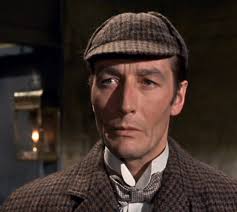



Both Anthony Quayle and repeating his role as Inspector Lestrade Frank Finlay would return for “Murder by Decree” released February 1, 1979 starring Christopher Plummer as Holmes and James Mason as Watson. This motion picture featured another fine cast headed by David Hemmings, Susan Clark, Donald Sutherland, Genevieve Bujold and John Gielguld.
The motion picture brings up the controversial idea that Queen Victoria’s son the aforementioned Prince Albert Victor was the Ripper due to his unacknowledged, by the crown at the time, mental illness. It also mentions another theory that fellow members in Freemasonry helped to protect Prince Albert Victor from being discovered by the Press and Public as the killer. The basic plot was borrowed from the equally controversial book on the crimes by Stephen Knight “Jack the Ripper: The Final Solution”.

Vincent Canby, of the New York Times,wrote in February 1979:
The film, directed by Bob Clark, based on an original screenplay by John Hopkins, makes use not only of the theory that Jack the Ripper was actually the Duke of Clarence, son of Queen Victoria, but also of Sherlock Holmes and Dr. Watson, who are apparently in the public domain, or at least available for assignments outside the works of Arthur Conan Doyle.
With Christopher Plummer as a charming, cultivated Holmes, a fellow who reveals himself to be a man of unexpected social and political conscience, and with James Mason as an especially fond and steadfast Watson, "Murder by Decree" is a good deal of uncomplicated fun, not in a class with Nicholas Meyer's "The Seven Percent Solution," but certainly miles ahead of many other current films that masquerade as popular entertainment.
Mr. Hopkins's screenplay is funny without being condescending, more aware of history, perhaps, than Conan Doyle's mysteries ever were, but always appreciative of the strengths of the original characters and of the etiquette observed in the course of every hunt.
This link will take my reader to the trailer for "Murder By Decree"
https://www.youtube.com/watch?v=JJIRu2pDE3I
A non-Holmes version of the story centering upon Prince Albert Victor as the Ripper first appeared ten years later in the Graphic Novel “From Hell” originally published in serial form between 1989 and 1996.


The Graphic novel would become a motion picture in 2001 starring Johnny Depp as the drug addicted Inspector Abberline. Below on the is a sequence from the Graphic Novel. On the right a still of Ian Holm as Sir William Gull the surgeon to the Royal Family as shown on the left in the Graphic Novel.
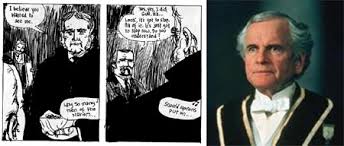



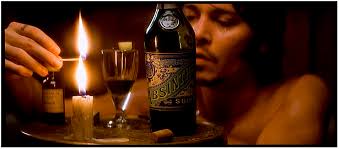
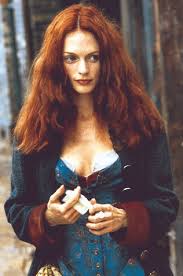

"From Hell" in either form goes with another theory that Sir William Gull was actually "Jack the Ripper", but adds a purpose ordered by the Freemason's again. Gull's mission is the protection of Prince Albert Victor who married a prostitute named Ann Crook. Crook. Who inn the story had a baby girl who would have been heir to the throne after the Prince. Gull is not killing five prostitutes at random, but the witnesses to the marriage.
This link is to a website "Casebook: Jack the Ripper" with an article by Christopher Scott covering the whole Annie "Ann" Crook story. It is very interesting reading:
http://www.casebook.org/ripper_media/book_reviews/non-fiction/castofthousands.crook.html
In both versions of "From Hell" Inspector Aberline falls in love with Mary Kelly who is not murdered by the Ripper in actuality, but ends her life raising the child of Ann Crook and the Prince. Alberdine dies from an overdose of opium his favorite narcotic before he could join her. After he received a letter that Kelly was not killed, but that Gull and apparently Scotland Yard mistook Ada a friend of Liz Stride for Mary.
The Graphic novel would become a motion picture in 2001 starring Johnny Depp as the drug addicted Inspector Abberline. Below on the is a sequence from the Graphic Novel. On the right a still of Ian Holm as Sir William Gull the surgeon to the Royal Family as shown on the left in the Graphic Novel.
"From Hell" in either form goes with another theory that Sir William Gull was actually "Jack the Ripper", but adds a purpose ordered by the Freemason's again. Gull's mission is the protection of Prince Albert Victor who married a prostitute named Ann Crook. Crook. Who inn the story had a baby girl who would have been heir to the throne after the Prince. Gull is not killing five prostitutes at random, but the witnesses to the marriage.
This link is to a website "Casebook: Jack the Ripper" with an article by Christopher Scott covering the whole Annie "Ann" Crook story. It is very interesting reading:
http://www.casebook.org/ripper_media/book_reviews/non-fiction/castofthousands.crook.html
In both versions of "From Hell" Inspector Aberline falls in love with Mary Kelly who is not murdered by the Ripper in actuality, but ends her life raising the child of Ann Crook and the Prince. Alberdine dies from an overdose of opium his favorite narcotic before he could join her. After he received a letter that Kelly was not killed, but that Gull and apparently Scotland Yard mistook Ada a friend of Liz Stride for Mary.
So who was Prince Albert Victor Christian Edward, Duke of Clarence and Avondale?

Born January 8, 1864 Albert Victor was the eldest son of Albert Edward the Prince of Wales. He was also therefore the grandson of Queen Victoria. Those two facts made the Prince second in line to the throne of England behind his father who would become King Edward VII and his daily actions where under a microscope, so to speak, by the citizens of the U.K.
As a young man Albert Victor became a Naval Cadet and traveled the world in both that capacity and as a representative of the Royal Family. He later joined the Army, but never served in any active military situations. Twice he unsuccessfully courted ladies for marriage and on his third attempt became engaged to Princess Mary of Teck near the end of 1891. She was technically a Princess of the German Kingdom of Wurttemberg, but was born in England and raised there within its upper class.
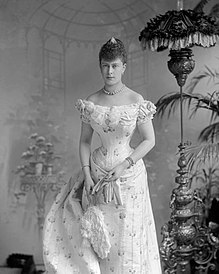
Unfortunately a few months after their engagement was announced a influenza pandemic spread through the U.K. and the Prince died during it. Princess Mary would eventually wed Albert Victor’s younger brother George who later in life became King George V in 1910.

Unfortunately a few months after their engagement was announced a influenza pandemic spread through the U.K. and the Prince died during it. Princess Mary would eventually wed Albert Victor’s younger brother George who later in life became King George V in 1910.
This seems to be both a tragic story and yet it reflects the normal life for a member of the monarchy. Except for one unusual event:
“Eddy” as the Prince had been called would be accused of being Jack the Ripper.
Let me now return to the “Cleveland Street Scandal” I mentioned above. The story begins in July 1889 a few months after the Whitechapel murders had seemingly stopped. The Metropolitan Police under Chief Inspector of Detectives Frederick George Abberline raided a male brothel run by a Charles Hammond located on Cleveland Street in a section of London.
Under questioning several of the male prostitutes and pimps broke down and created a list of their client's names. One of the names mentioned was that of Lord Arthur Somerset. Lord Somerset was the “Extra Equerry” a personal attendant to the British royal household and specifically the Prince of Wales.
For my readers information until an "Act of Law" 78 years after the scandal was passed by the British Parliament. The obvious fact that Lord Somerset was homosexual should have gotten him a sentence of two years imprisonment with hard labor in 1889. So the seriousness of his name being mentioned by the male prostitutes and his "position" in life reflected directly upon the Royal household.
Further effecting the Royal Family where the rumors that began to circulate that one of the other clients on the list was Prince Albert Victor himself. The prostitutes and their pimps had never mentioned him. It is believed that Lord Somerset’s solicitor Arthur Newton started the rumors to take some of the pressure off of his client. In the end the Prince of Wales became involved with the investigation resulting in no clients of the male brothel ever being prosecuted. This intervention has caused some writers to speculate that the Prince of Wales' action was part of a cover up to protect Albert Victor. Whatever position you take now. At the time the damage was done in the public's mind and many people believed Albert Victor was homosexual and that "fact" plus further rumors of syphilis contracted from prostitutes while the Prince was in the Navy, became to the average member of the British Empire the real causes of his death and not influenza.
As to Arthur Newton following the "Cleveland Scandal" he would be convicted of "Obstruction of Justice". It was also discovered that Newton assisted some of his clients in escaping the country. For those offensives he served six weeks in prison. Then in 1910 Arthur Newton was "Struck Off" the records as a solicitor in the U,K. for one year and could not practice law. He had been found guilty of falsifying letters and other documents for his client the notorious British murderer "Dr. Crippen".
All of this brings me to the Prince being the Whitechapel murderer. The first mention of Prince Albert Victor as the Ripper was in a biography of his father “Edouard VII” by Phillipe Jullian in 1962 74 years after the events of 1888.
Jullian was a French Illustrator, Art Historian and Biographer. He was also noted as a novelist. Where he got his information is never explained and may have been a touch of the novelist, but the story was in print in a biography by a known author for the world to read as it was published in several languages.
The next time the theory appears is 8 years after Jullian's biography in the British publication "The Criminologist" Volume 5, Number 8, for November 1970. The person making the accusation was the distinguished Dr. Thomas Eldon Alexander Stowell, C.B.E., M.D., F.R.C.S. in his article "Jack the Ripper: A Solution" found on pages 41 to 51.
Fortunately, or unfortunately depending upon your point of view Dr. Stowell died on November 8, 1970 at the age of 85. Shortly after the issue of "The Criminologist" had been released. Prior to his death the doctor sent a letter to "The London Times" claiming his suspect "S" was not Prince Albert Victor as everyone was implying. So after a brief mention by Phillpe Jullian in a biography about Albert Victor's father and a magazine article that the author wrote was not about the Prince. The story that the Duke of Clarence was "Jack the Ripper", became fact to the general populace.
The theory would solidify in 1976 within the pages of author Stephen Knight's work "Jack the Ripper: The Final Solution". Which I mentioned formed the basis for the story lines of the motion picture "Murder By Decree" in 1979, the 1989-1996 Graphic novel serial "From Hell" and its follow up motion picture in 2001.

Once more I am quoting form the website: "Casebook: Jack the Ripper" to counter these claims that the Prince was the Ripper:
“Eddy” as the Prince had been called would be accused of being Jack the Ripper.
Let me now return to the “Cleveland Street Scandal” I mentioned above. The story begins in July 1889 a few months after the Whitechapel murders had seemingly stopped. The Metropolitan Police under Chief Inspector of Detectives Frederick George Abberline raided a male brothel run by a Charles Hammond located on Cleveland Street in a section of London.
Under questioning several of the male prostitutes and pimps broke down and created a list of their client's names. One of the names mentioned was that of Lord Arthur Somerset. Lord Somerset was the “Extra Equerry” a personal attendant to the British royal household and specifically the Prince of Wales.
For my readers information until an "Act of Law" 78 years after the scandal was passed by the British Parliament. The obvious fact that Lord Somerset was homosexual should have gotten him a sentence of two years imprisonment with hard labor in 1889. So the seriousness of his name being mentioned by the male prostitutes and his "position" in life reflected directly upon the Royal household.
Further effecting the Royal Family where the rumors that began to circulate that one of the other clients on the list was Prince Albert Victor himself. The prostitutes and their pimps had never mentioned him. It is believed that Lord Somerset’s solicitor Arthur Newton started the rumors to take some of the pressure off of his client. In the end the Prince of Wales became involved with the investigation resulting in no clients of the male brothel ever being prosecuted. This intervention has caused some writers to speculate that the Prince of Wales' action was part of a cover up to protect Albert Victor. Whatever position you take now. At the time the damage was done in the public's mind and many people believed Albert Victor was homosexual and that "fact" plus further rumors of syphilis contracted from prostitutes while the Prince was in the Navy, became to the average member of the British Empire the real causes of his death and not influenza.
As to Arthur Newton following the "Cleveland Scandal" he would be convicted of "Obstruction of Justice". It was also discovered that Newton assisted some of his clients in escaping the country. For those offensives he served six weeks in prison. Then in 1910 Arthur Newton was "Struck Off" the records as a solicitor in the U,K. for one year and could not practice law. He had been found guilty of falsifying letters and other documents for his client the notorious British murderer "Dr. Crippen".
All of this brings me to the Prince being the Whitechapel murderer. The first mention of Prince Albert Victor as the Ripper was in a biography of his father “Edouard VII” by Phillipe Jullian in 1962 74 years after the events of 1888.
Jullian was a French Illustrator, Art Historian and Biographer. He was also noted as a novelist. Where he got his information is never explained and may have been a touch of the novelist, but the story was in print in a biography by a known author for the world to read as it was published in several languages.
The next time the theory appears is 8 years after Jullian's biography in the British publication "The Criminologist" Volume 5, Number 8, for November 1970. The person making the accusation was the distinguished Dr. Thomas Eldon Alexander Stowell, C.B.E., M.D., F.R.C.S. in his article "Jack the Ripper: A Solution" found on pages 41 to 51.
Fortunately, or unfortunately depending upon your point of view Dr. Stowell died on November 8, 1970 at the age of 85. Shortly after the issue of "The Criminologist" had been released. Prior to his death the doctor sent a letter to "The London Times" claiming his suspect "S" was not Prince Albert Victor as everyone was implying. So after a brief mention by Phillpe Jullian in a biography about Albert Victor's father and a magazine article that the author wrote was not about the Prince. The story that the Duke of Clarence was "Jack the Ripper", became fact to the general populace.
The theory would solidify in 1976 within the pages of author Stephen Knight's work "Jack the Ripper: The Final Solution". Which I mentioned formed the basis for the story lines of the motion picture "Murder By Decree" in 1979, the 1989-1996 Graphic novel serial "From Hell" and its follow up motion picture in 2001.
Once more I am quoting form the website: "Casebook: Jack the Ripper" to counter these claims that the Prince was the Ripper:
More importantly, examination of court and Royal records reveal that Eddy was not even in London on the important murder dates.
29 August-7 September 1888: The Prince was staying with Viscount Downe at Danby Lodge, Grosmont, Yorkshire. (Nichols murdered 31 August.)
7-10 September 1888: The Prince was at the Cavalry Barracks in York. (Chapman murdered 8 September.)
27-30 September: The Prince was at Abergeldie, Scotland, where Queen Victoria recorded in her journal that he lunched with her on 30 September. (Stride and Eddowes murdered between 1.00 and 2.00 a.m., 30 September.)
1 November: Arrived in London from York.
2-12 November: The Prince was at Sandringham. (Kelly murdered 9 November)
http://www.casebook.org/suspects/eddy.html
Of course those who believe otherwise would state these documents are false and were created as part of the cover-up.
Of course those who believe otherwise would state these documents are false and were created as part of the cover-up.
As we are on the subject let’s look at two other Jack the Ripper films, one for television and the other theatrical release, that keep the Ripper killings tied to Prince Albert Victor.
In 1988 a two part television mini-series simply using the title “Jack the Ripper” was released with Michael Caine as an alcoholic Inspector Abberline. The release was timed to correspond to the 100th Anniversary of the murders.


In 1988 a two part television mini-series simply using the title “Jack the Ripper” was released with Michael Caine as an alcoholic Inspector Abberline. The release was timed to correspond to the 100th Anniversary of the murders.
The series goes into almost every possible suspect known in the case including actor Richard Mansfield who left London right after the last documented murder for the United States. It was Mansfield that Harlan Ellison used as a model for that episode of Stuart Whitman’s television show “Cimarron Strip" I mentioned earlier.
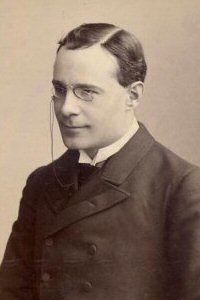

Mansfield was appearing on the London stage as “Dr. Jekyll and Mr. Hyde” and did a transformation scene in full view of the audience. Adding to the lure of Mansfield being the Ripper was that his father was a German wine-merchant and his mother a Russian opera singer. The whole idea of Mansfield being the Ripper came from a frightened patron who saw Jekyll and Hyde and decided that no actor could make so convincing a stage transformation without being homicidal themselves. In the frenzy pf the time many people in London bought into that patron’s fear as real. Including Scotland Yard who was looking for any lead possible. Even the ridiculous idea created by a patron's fear of an actor's performance.
Below is a double exposure publicity shot of Mansfield as both "Dr, Jekyll and Mr. Hyde".
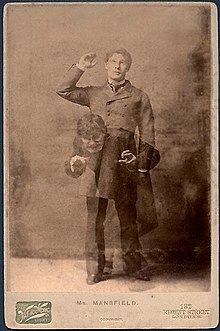
The TV mini-series makes the mistake of calling Mansfield an American actor. He was actually born in Germany, but spent his early childhood on the German island of Heligoland which was under British rule. Armand Assante played Mansfield and earned both a Golden Globe and Emmy nomination for his performance,
The mini-series concludes that the idea of Albert Victor being the Ripper was a red-herring and the writers and producers point the killings at Surgeon Sir William Gull once more.
The series ends with the following on the screen title:
In the strange case of Jack the Ripper, there was no trial and no signed confession.
In 1888, neither fingerprinting nor blood typing was in use and no conclusive forensic, documentary or eye-witness testimony was available. Thus, positive proof of The Ripper’s identity is not available.
We have come to our conclusions after careful study and painstaking deduction. Other researchers, criminologists and writers may take a different view.
We believe our conclusions to be true.
In 1997 there was a Australian/United States take on Prince Albert Victor entitled “The Ripper” proving you can’t keep a juicy theory down. The usual suspects were here except Abberline who was now actor Patrick Bergin as Inspection Jim Hansen.
The plot is more interested in those people who have been mentioned over the years as being involved rather than the murders, or the murderer himself. The movie is full of fictional events revolving around Albert Victor, Dr. Gull and the created Inspector Hansen than the facts.
The plot is more interested in those people who have been mentioned over the years as being involved rather than the murders, or the murderer himself. The movie is full of fictional events revolving around Albert Victor, Dr. Gull and the created Inspector Hansen than the facts.
Do not confuse the Australian/United States motion picture with another from 2001 also titled "The Ripper" aka: "The Ripper: Letter from Hell". This is a United States/Canadian motion picture which is nothing more than a modern slasher film without even the history of the novel that the 2009 "The Lodger" has to fell back upon,The plot has the standard survivor of a massacre studying serial killers under a famous teacher at a college. The audience watches as the other students start being killed off one by one as a result of the influenced caused by a letter supposedly from the Ripper . Raising the question is that survivor sane or not?
I’d like to finish this article with three interesting motion picture examples of films using the character of "Jack the Ripper". However, not necessarily the events.
In October 1971 Hammer Studios released two movies related in some respects to Jack the Ripper. The first was released October 3, 1971 in the U,K, and on July 13, 1972 in the United States.
"Hands of the Ripper” used the tag line:
"Hands of the Ripper” used the tag line:
The Hands of Jack the Ripper Live Again As His Fiendish Daughter Kills Again And Again And AgainThe "R" rated film was also made into a comic book in the U,K,
We move from Victorian London to Edwardian. Where a young girl named Anna is being exploited by her guardian a fake medium. Apparently she has a subconscious memory of her mother being murdered by Jack the Ripper. Anna is taken to a "Freudian" psychiatrist who is determined to discover the truth to her murderous impulses. Leading to the idea that she is possessed by her father (?) the Ripper and hence her hands are controlled by his spirit. Which makes the film somewhat of a revision of the classic story by French author Maurice Renard "Les Mains di Orlac (The Hands of Orlac). The novel had been made into several film versions prior to "The Hands of Jack the Ripper" starting in 1924. The last was in 1960 made in England as a co-production with France. The picture starred Mel Ferrer and featured Christopher Lee. The story tells of a brilliant concert pianist who has an accident causing his hands to be badly damaged. They are replaced by new one;s that belonged to a murderer and the pianist apparently becomes a killer.
Here is a link to the British release by "The Rank Organization":
http://www.dailymotion.com/video/x28go1s_hands-of-the-ripper-1971_shortfilms
The second Hammer film which was released on October 17, 1971 in the U,K. and during April 1972 in the United States is weird to say the least, but really fun. The film stars both Ralph Bates and Martine Beswick in the dual title roles of “Dr. Jekyll and Sister Hyde”.
The motion picture is set in 1888 and not only borrowers its story from Robert Louis Stevenson’s “The Strange Case of Dr. Jekyll and Mr. Hyde”, but Stevenson’s “The Body Snatcher”, By changing Stevenson's fictions version of the real body snatchers of the period the two William’s Burke and Hare into the real ones. The duo supply Henry Jekyll with corpses from which Jekyll extracts female hormones!
Below is a publicity shot containing both Dr.Jekyll and Sister Hyde.
So where does Jack fit in?
Along with the internal battle between the male and female sides of Dr. Jekyll's personality for total control of it. At the same time as his experiments in London there have been a series of murders committed by a fiend Scotland Yard has named "Jack the Ripper". The police with a little help from William Hare to avoid being considered are led to believe that Henry Jekyll is the Ripper. During the climatic pursuit the male Jekyll attempts to climb a building to escape, but realizes the futility of it. Jekyll fights to keep the female Sister Hyde in check as she hasn’t the strength to prevent him from falling, but Henry looses. She/He drops to the ground leaving a corpse half male, half female for the police and on lookers to just stare at.
Here is a link to the motion picture in wide screen, but with Spanish subtitles.
https://www.youtube.com/watch?v=Pqd5cF3u-k8
Here is a link to the motion picture in wide screen, but with Spanish subtitles.
https://www.youtube.com/watch?v=Pqd5cF3u-k8
My last example is a really fun film written and directed by Nicholas Meyer, "Star Trek" The Wrath of Khan" and the Sherlock Holmes novel "The Seven Percent Solution", from 1979 called “Time After Time”. The film blends one of the most charming performances by Malcolm McDowell as H.G. Wells with the most evil David Warner as the Ripper and the innocence and confusion of a women in danger Mary Steenburgen.

For those unfamiliar with the movie. Imagine first that the real reason H.G. Wells could see the future so well was because he had been there. H.G. had actually built “The Time Machine” of his 1895 novel. At a dinner party with some friends Wells mentions his machine and shows it to his guest. Afterwards the police knock on the door> They have a doctor's bag with blood stained gloves belonging to Wells' good friend Dr. John Leslie Stevenson/ Who attending the party, but both Stevenson and the Time Machine are now gone ending the reign of terror caused by Jack the Ripper in Whitechapel.


What Wells did not mention to his guests is that his machine has a safety return device which also shows were and when it has been too. When the machine returns H.G. uses it and finds himself in 1979 San Francisco and on the pursuit of Stevenson. When they finally meet again later in the movie. Stevenson remarks:

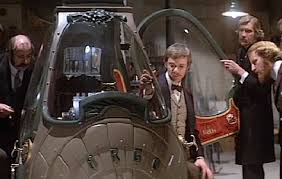
Ninety years ago, I was a freak. Now... I'm an amateur.Mentioning "Future man's propensity for violence",
H.G. meets Amy Robbins a bank clerk who eventually becomes his ally, romantic interest and a target for Stevenson.

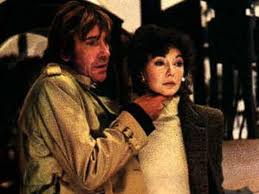
There is a scene that the real Wells would have appreciated. As H.G. comments on the Social Situation of America based upon a visit to a McDonalds. At the end of the movie after Stevenson is dead. Wells and Amy will return to his London of 1888 and marry. Amy remarks about changing her name to Susan B. Anthony.
There are other motion pictures and television documentaries that I have not covered in this article. My stated purpose was to illustrate how the two mediums portrayed "Jack the Ripper" and not solve the now, at the time of this writing, 127 year old murders that still seem to fascinate us over all the others. I will take a stab at the overall case by saying that the reason Scotland Yard never solved the five Whitechapel murders was because SHE was just smarter than the Yard.
There is a scene that the real Wells would have appreciated. As H.G. comments on the Social Situation of America based upon a visit to a McDonalds. At the end of the movie after Stevenson is dead. Wells and Amy will return to his London of 1888 and marry. Amy remarks about changing her name to Susan B. Anthony.
There are other motion pictures and television documentaries that I have not covered in this article. My stated purpose was to illustrate how the two mediums portrayed "Jack the Ripper" and not solve the now, at the time of this writing, 127 year old murders that still seem to fascinate us over all the others. I will take a stab at the overall case by saying that the reason Scotland Yard never solved the five Whitechapel murders was because SHE was just smarter than the Yard.




No comments:
Post a Comment